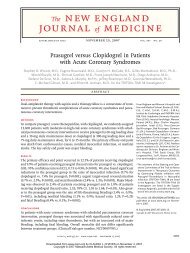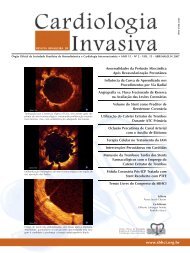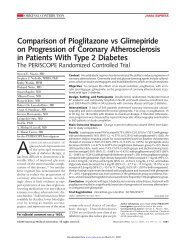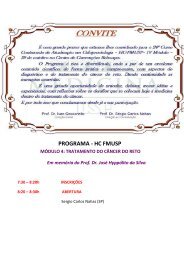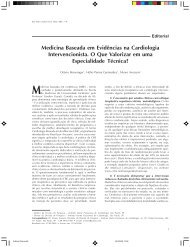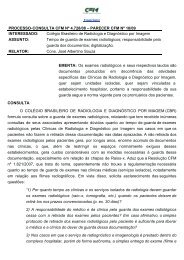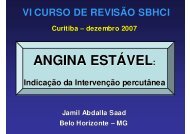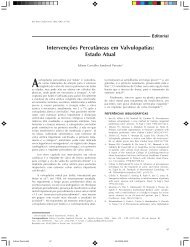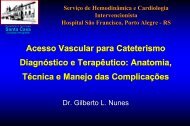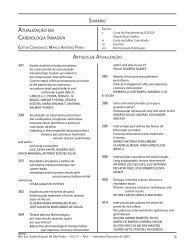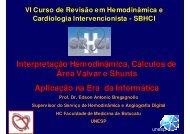IVUS-Guided LM Stenting
IVUS-Guided LM Stenting
IVUS-Guided LM Stenting
You also want an ePaper? Increase the reach of your titles
YUMPU automatically turns print PDFs into web optimized ePapers that Google loves.
<strong>IVUS</strong>-<strong>Guided</strong> <strong>LM</strong> <strong>Stenting</strong><br />
Technique and Outcomes<br />
Young-Hak Kim, MD, PhD,<br />
On behalf of CROSS and PERFECT investigators.<br />
Cardiac Center, University of Ulsan College of Medicine<br />
Asan Medical Center, Seoul, Korea<br />
Monday, December 7, 2009
Monday, December 7, 2009<br />
It took 1.5 days<br />
from Seoul, Korea to Curitiba, Brazil..
Monday, December 7, 2009<br />
It took 1.5 days<br />
from Seoul, Korea to Curitiba, Brazil..
Monday, December 7, 2009
Monday, December 7, 2009
Monday, December 7, 2009
Monday, December 7, 2009
Upgrade of Recommendation<br />
for PCI at Unprotected Left Main Stenosis<br />
Monday, December 7, 2009<br />
Circulation, 2009 NOV
Upgrade of Recommendation<br />
for PCI at Unprotected Left Main Stenosis<br />
<strong>Stenting</strong> is relatively more favorable for<br />
• Patients with isolated U<strong>LM</strong>CA lesions or 1-vessel disease,<br />
• Patients with ostial or mid U<strong>LM</strong>CA,<br />
• patients with factors for high-risk CABG.<br />
CABG may be relatively more favorable for<br />
• Patients with U<strong>LM</strong>CA plus multivessel disease,<br />
• Distal/bifurcation U<strong>LM</strong>CA lesions, or<br />
• Low surgical risk with a good chance of technical success.<br />
Monday, December 7, 2009<br />
Circulation, 2009 NOV
Upgrade of Recommendation<br />
for PCI at Unprotected Left Main Stenosis<br />
<strong>Stenting</strong> is relatively more favorable for<br />
• Patients with isolated U<strong>LM</strong>CA lesions or 1-vessel disease,<br />
• Patients with ostial or mid U<strong>LM</strong>CA,<br />
• patients with factors for high-risk CABG.<br />
CABG may be relatively more favorable for<br />
• Patients with U<strong>LM</strong>CA plus multivessel disease,<br />
• Distal/bifurcation U<strong>LM</strong>CA lesions, or<br />
• Low surgical risk with a good chance of technical success.<br />
Monday, December 7, 2009<br />
Circulation, 2009 NOV
An <strong>IVUS</strong>-guided stepwise approach<br />
make you feel comfortable..<br />
• Lesion assessment<br />
• Selection of PCI technique<br />
• Selection of appropriate device<br />
• Procedural optimization<br />
• Assessment of DES failures<br />
Monday, December 7, 2009
<strong>IVUS</strong>-<strong>Guided</strong> <strong>LM</strong> <strong>Stenting</strong><br />
• Lesion assessment<br />
• Selection of PCI technique<br />
• Selection of appropriate device<br />
• Procedural optimization<br />
• Assessment of DES failures<br />
Monday, December 7, 2009
Treat or not Treat<br />
Big discrepancy !<br />
EEM : 14.04mm 2<br />
Lumen : 4.0mm 2<br />
Area stenosis : 71.5%<br />
Monday, December 7, 2009
Treat or not Treat<br />
Monday, December 7, 2009<br />
Courtesy of Dr. Gary S. Mintz
Treat or not Treat<br />
0 1.0 4.0mm<br />
Monday, December 7, 2009<br />
Courtesy of Dr. Gary S. Mintz
We can treat the <strong>LM</strong> disease<br />
in a case of MLA < 6.0 mm 2 …<br />
Prediction of FFR (0.75) with <strong>IVUS</strong> parameter<br />
2.8mm 5.9mm 2<br />
67% 50%<br />
Monday, December 7, 2009<br />
Jasti V et al. Circulation 2004;110:2831
Plaque Characterization<br />
• Lesion preparation : need of rotablation, debulking<br />
• Drug : need of IIb/IIIa, aggressive antiplatelets<br />
Fibrous plaque<br />
Plaque rupture<br />
Thrombi<br />
Calcification<br />
Monday, December 7, 2009<br />
Courtesy of Dr. Gary S. Mintz
<strong>IVUS</strong>-<strong>Guided</strong> <strong>LM</strong> <strong>Stenting</strong><br />
• Lesion assessment<br />
• Selection of PCI technique<br />
• Selection of appropriate device<br />
• Procedural optimization<br />
• Assessment of DES failures<br />
Monday, December 7, 2009
Ostial and Shaft<br />
<strong>LM</strong> lesions<br />
Monday, December 7, 2009
<strong>IVUS</strong> Exam is very useful to assess…<br />
1. vessel size and lesion length<br />
2. presence of bifurcation stenosis<br />
3. optimal stent expansion with complete apposition<br />
Monday, December 7, 2009
Normal : LAD ostium, bifurcation and shaft<br />
Mild disease : LCX ostium<br />
Monday, December 7, 2009
<strong>Stenting</strong> with Xience V 4.0 x 15mm<br />
Monday, December 7, 2009
<strong>Stenting</strong> with Xience V 4.0 x 15mm<br />
It is very simple but please remember<br />
1. Ultras-short stent (< 10mm) is not good due to the likelihood of stent<br />
slippage.<br />
2. Big balloon dilatation (>4mm) is useful to avoid inapposition.<br />
3. Minimal protrusion of stent into aorta is fine.<br />
4. Final <strong>IVUS</strong> exam is mandatory.<br />
Monday, December 7, 2009
No inapposition<br />
No touch in LAD os or LCX os<br />
Worst area : 9.6 mm 2<br />
Monday, December 7, 2009
Os and Shaft <strong>LM</strong> stenting<br />
2-Year Outcomes<br />
International Multicenter Registry<br />
In Hospital<br />
Follow-Up<br />
(886±308 days)<br />
Cardiac death, n (%) 0 4(2.7)<br />
Cardiac death in 60 high-risk<br />
0 4(6.6)<br />
patients, n (%)<br />
Cardiac death in 87 low-risk<br />
patients, n (%)<br />
0 0<br />
Total death, n (%) 1 (0.7) 5(3.4)<br />
Q-wave MI, n (%) 0 1 (0.7)<br />
Non-Q-wave MI, n (%) 5 (3.4) 2 (1.4)<br />
TLR, n (%) 1 (0.7) 1 (0.7)<br />
TVR, n (%) 1 (0.7) 7 (4.7)<br />
MACE, n (%) 6 (4.0) 11 (7.4)<br />
Monday, December 7, 2009<br />
Chieffo A, Kim YH, Park SJ et al. Circulation 2007;116:158
Left Main<br />
Bifurcation Approach<br />
Monday, December 7, 2009
Treatment for Bifurcation <strong>LM</strong><br />
1-stent in <strong>LM</strong><br />
& for LCX with ..<br />
2-stent in <strong>LM</strong><br />
& LCX with ..<br />
1) No touch<br />
2) Provisional kissing<br />
3) Provisional T stenting<br />
4) Provisional Culotte<br />
5) Reverse crush<br />
6) Others<br />
1) Simultaneous kissing<br />
2) V-stenting<br />
3) Crush<br />
4) Culotte<br />
5) T-stenting<br />
6) Others<br />
Monday, December 7, 2009
<strong>IVUS</strong>-guided,<br />
Lesion-specific<br />
Single<br />
stent<br />
Two<br />
stent<br />
Normal ostial LCX with MEDINA 1.1.0. or 1.0.0.<br />
Small LCX with < 2.5 mm in diameter<br />
Ostial LCX area ≥ 4 mm 2 by <strong>IVUS</strong><br />
Diminutive LCX<br />
Normal or focal disease in distal LCX<br />
Diseased LCX with MEDINA 1.1.1., 1.0.1., or 0.1.1<br />
Large LCX with ≥ 2.5 mm in diameter<br />
Ostial LCX area < 4 mm 2 by <strong>IVUS</strong><br />
Diseased left dominant coronary system<br />
Concomitant diffuse disease in distal LCX<br />
Park SJ, Kim YH. Colombo A, Issam D. Moussa et al. Textbook of Bifurcation <strong>Stenting</strong><br />
Monday, December 7, 2009
<strong>IVUS</strong>-guided,<br />
Lesion-specific<br />
Single<br />
stent<br />
Two<br />
stent<br />
Normal ostial LCX with MEDINA 1.1.0. or 1.0.0.<br />
Small LCX with < 2.5 mm in diameter<br />
Ostial LCX area ≥ 4 mm 2 by <strong>IVUS</strong><br />
Diminutive LCX<br />
Normal or focal disease in distal LCX<br />
Diseased LCX with MEDINA 1.1.1., 1.0.1., or 0.1.1<br />
Large LCX with ≥ 2.5 mm in diameter<br />
Ostial LCX area < 4 mm 2 by <strong>IVUS</strong><br />
Diseased left dominant coronary system<br />
Concomitant diffuse disease in distal LCX<br />
Park SJ, Kim YH. Colombo A, Issam D. Moussa et al. Textbook of Bifurcation <strong>Stenting</strong><br />
Monday, December 7, 2009
Left Main Stenosis with Normal LCX<br />
• 60 Yr / Male<br />
• Stable angina<br />
• Scheduled to receive a surgery for ureter stone<br />
• Hypertension with normal EF (56%)<br />
Monday, December 7, 2009
Decision-Making of <strong>LM</strong> Lesion by <strong>IVUS</strong><br />
Ostial LAD Distal <strong>LM</strong>CA Ostial LCX<br />
4.9 mm 2 (79%) 4.8 mm 2 (71%) 5.5 mm 2 (40%)<br />
Monday, December 7, 2009
Single<br />
stent<br />
Two<br />
stent<br />
Normal ostial LCX with MEDINA 1.1.0. or<br />
1.0.0.<br />
Small LCX with < 2.5 mm in diameter<br />
Ostial LCX area ≥ 4 mm 2 by <strong>IVUS</strong><br />
Diminutive LCX<br />
Diseased LCX with MEDINA 1.1.1., 1.0.1., or 0.1.1<br />
Normal or focal disease in distal LCX<br />
Large LCX with ≥ 2.5 mm in diameter<br />
Ostial LCX area < 4 mm 2 by <strong>IVUS</strong><br />
Diseased left dominant coronary system<br />
Concomitant diffuse disease in distal LCX<br />
Park SJ, Kim YH. Colombo A, Issam D. Moussa et al. Textbook of Bifurcation <strong>Stenting</strong><br />
Monday, December 7, 2009
One-Stent Technique<br />
Predilation<br />
Monday, December 7, 2009
One-Stent Technique<br />
Predilation<br />
Xience V 2.75 * 28 mm<br />
Monday, December 7, 2009
One-Stent Technique<br />
Predilation<br />
Xience V 2.75 * 28 mm<br />
Xience V 3.0 * 24 mm<br />
Monday, December 7, 2009
One-Stent Technique<br />
Predilation<br />
Xience V 2.75 * 28 mm<br />
Xience V 3.0 * 24 mm<br />
Xience V 4.0 * 28 mm<br />
Monday, December 7, 2009
One-Stent Technique<br />
Predilation<br />
Xience V 2.75 * 28 mm<br />
Xience V 3.0 * 24 mm<br />
Xience V 4.0 * 28 mm<br />
Postdilation<br />
Monday, December 7, 2009
Monday, December 7, 2009<br />
Final Angiogram
<strong>IVUS</strong> at Ostial LCX<br />
Carina Shift without Plaque<br />
LAD<br />
LCX os 3.3 mm 2 (46%)<br />
LCX to <strong>LM</strong><br />
Longitudinal view<br />
<strong>IVUS</strong> from LCX<br />
Monday, December 7, 2009
Kissing balloon inflation<br />
Not mandatory<br />
FFR in LCX<br />
Indicated in<br />
Significant LCX jail<br />
TIMI flow < 3<br />
Dissection<br />
Low FFR < 0.80<br />
Monday, December 7, 2009
Unadjusted Outcomes of MAIN-COMPARE<br />
Study in Korea Between 1- vs. 2-Stent<br />
Cumulative incidence (%)<br />
15<br />
10<br />
5<br />
0<br />
0<br />
Death<br />
P=0.62<br />
1-stent<br />
2-stent<br />
0.5 1.0 1.5 2.0 2.5 3.0yrs<br />
Cumulative incidence (%)<br />
20<br />
15<br />
10<br />
5<br />
0<br />
0<br />
MI<br />
P=0.009<br />
0.5 1.0 1.5 2.0 2.5 3.0yrs<br />
Cumulative incidence (%)<br />
30<br />
20<br />
10<br />
0<br />
0<br />
TVR<br />
P
<strong>IVUS</strong>-guided,<br />
Lesion-specific<br />
Single<br />
stent<br />
Two<br />
stent<br />
Normal ostial LCX with MEDINA 1.1.0. or 1.0.0.<br />
Small LCX with < 2.5 mm in diameter<br />
Ostial LCX area ≥ 4 mm 2 by <strong>IVUS</strong><br />
Diminutive LCX<br />
Normal or focal disease in distal LCX<br />
Diseased LCX with MEDINA 1.1.1., 1.0.1., or 0.1.1<br />
Large LCX with ≥ 2.5 mm in diameter<br />
Ostial LCX area < 4 mm 2 by <strong>IVUS</strong><br />
Diseased left dominant coronary system<br />
Concomitant diffuse disease in distal LCX<br />
Park SJ, Kim YH. Colombo A, Issam D. Moussa et al. Textbook of Bifurcation <strong>Stenting</strong><br />
Monday, December 7, 2009
<strong>LM</strong> with 3 Vessel Disease<br />
• 76 Yr / Male<br />
• Diabetic on oral hypoglycemics<br />
• Unstable angina with EF of 63%<br />
Monday, December 7, 2009
Monday, December 7, 2009<br />
Mild Ostial LCX Stenosis
Monday, December 7, 2009<br />
Mild Ostial LCX Stenosis
Side branch assessment<br />
<strong>LM</strong><br />
LAD<br />
LCX<br />
Monday, December 7, 2009
Side branch assessment<br />
<strong>LM</strong><br />
LAD<br />
LCX<br />
LCX os<br />
From LAD<br />
Monday, December 7, 2009
Side branch assessment<br />
2.2 mm 2<br />
<strong>LM</strong><br />
LCX os From<br />
LCX<br />
LAD<br />
LCX<br />
LCX os<br />
From LAD<br />
Monday, December 7, 2009
Single<br />
stent<br />
<br />
<br />
<br />
<strong>IVUS</strong>-guided,<br />
Lesion-specific<br />
Normal ostial LCX with MEDINA 1.1.0. or<br />
1.0.0.<br />
Small LCX with < 2.5 mm in diameter<br />
Ostial LCX area ≥ 4 mm 2 by <strong>IVUS</strong><br />
Two<br />
stent<br />
Diminutive LCX<br />
Normal Diseased or LCX focal with disease MEDINA in distal 1.1.1., LCX1.0.1., or 0.1.1<br />
Large LCX with ≥ 2.5 mm in diameter<br />
Ostial LCX area < 4 mm 2 by <strong>IVUS</strong><br />
<br />
Diseased left dominant coronary system<br />
<br />
Concomitant diffuse disease in distal LCX<br />
Park SJ, Kim YH. Colombo A, Issam D. Moussa et al. Textbook of Bifurcation <strong>Stenting</strong><br />
Monday, December 7, 2009
<strong>Stenting</strong> in LAD and LCX<br />
Followed by Crushing in Distal <strong>LM</strong><br />
Several <strong>IVUS</strong> exams were done for optimal stenting<br />
Predilation<br />
Monday, December 7, 2009
<strong>Stenting</strong> in LAD and LCX<br />
Followed by Crushing in Distal <strong>LM</strong><br />
Several <strong>IVUS</strong> exams were done for optimal stenting<br />
Predilation<br />
Xience V 3.0 * 28 mm<br />
Monday, December 7, 2009
<strong>Stenting</strong> in LAD and LCX<br />
Followed by Crushing in Distal <strong>LM</strong><br />
Several <strong>IVUS</strong> exams were done for optimal stenting<br />
Predilation<br />
Xience V 3.0 * 28 mm<br />
Predilation<br />
Monday, December 7, 2009
<strong>Stenting</strong> in LAD and LCX<br />
Followed by Crushing in Distal <strong>LM</strong><br />
Several <strong>IVUS</strong> exams were done for optimal stenting<br />
Predilation<br />
Xience V 3.0 * 28 mm<br />
Predilation<br />
Xience V 2.75 * 18 mm<br />
Monday, December 7, 2009
<strong>Stenting</strong> in LAD and LCX<br />
Followed by Crushing in Distal <strong>LM</strong><br />
Several <strong>IVUS</strong> exams were done for optimal stenting<br />
Predilation<br />
Xience V 3.0 * 28 mm<br />
Predilation<br />
Xience Kissing V 2.75 balloon * 18 mm<br />
Monday, December 7, 2009
<strong>Stenting</strong> in LAD and LCX<br />
Followed by Crushing in Distal <strong>LM</strong><br />
Several <strong>IVUS</strong> exams were done for optimal stenting<br />
Predilation<br />
Xience V 3.0 * 28 mm<br />
Predilation<br />
Xience Kissing V 2.75 balloon * 18 mm<br />
After kissing balloon<br />
Monday, December 7, 2009
<strong>Stenting</strong> in LAD and LCX<br />
Followed by Crushing in Distal <strong>LM</strong><br />
Several <strong>IVUS</strong> exams were done for optimal stenting<br />
Predilation<br />
Xience V 3.0 * 28 mm<br />
Predilation<br />
Xience Kissing V 2.75 balloon * 18 mm<br />
After kissing balloon<br />
Xience V 3.0 * 23 mm<br />
Monday, December 7, 2009
<strong>Stenting</strong> in LAD and LCX<br />
Followed by Crushing in Distal <strong>LM</strong><br />
Several <strong>IVUS</strong> exams were done for optimal stenting<br />
Predilation<br />
Xience V 3.0 * 28 mm<br />
Predilation<br />
Xience Kissing V 2.75 balloon * 18 mm<br />
After kissing balloon<br />
Xience Xience V 3.0 V 3.5 * 23 * mm 28 mm<br />
Monday, December 7, 2009
<strong>Stenting</strong> in LAD and LCX<br />
Followed by Crushing in Distal <strong>LM</strong><br />
Several <strong>IVUS</strong> exams were done for optimal stenting<br />
Predilation<br />
Xience V 3.0 * 28 mm<br />
Predilation<br />
Xience Kissing V 2.75 balloon * 18 mm<br />
After kissing balloon<br />
Xience Xience V 3.0 V 3.5 * 23 * mm<br />
Non-com. balloon<br />
28 mm<br />
3.0 to 25atm<br />
Monday, December 7, 2009
<strong>Stenting</strong> in LAD and LCX<br />
Followed by Crushing in Distal <strong>LM</strong><br />
Several <strong>IVUS</strong> exams were done for optimal stenting<br />
Predilation<br />
Xience V 3.0 * 28 mm<br />
Predilation<br />
Xience Kissing V 2.75 balloon * 18 mm<br />
After kissing balloon<br />
Xience Xience V 3.0 V 3.5 * 23 * mm<br />
Non-com. balloon<br />
28 mm<br />
3.0 to 25atm<br />
Non-com. balloon 3.5 at 25atm<br />
Monday, December 7, 2009
<strong>Stenting</strong> in LAD and LCX<br />
Followed by Crushing in Distal <strong>LM</strong><br />
Several <strong>IVUS</strong> exams were done for optimal stenting<br />
Predilation<br />
Xience V 3.0 * 28 mm<br />
Predilation<br />
Xience Kissing V 2.75 balloon * 18 mm<br />
After kissing balloon<br />
Xience Xience V 3.0 V 3.5 * 23 * mm<br />
Non-com. balloon<br />
28 mm<br />
3.0 to 25atm<br />
Non-com. Kissing balloon at 10 3.5 atm 25atm in both<br />
Monday, December 7, 2009
<strong>Stenting</strong> in LAD and LCX<br />
Followed by Crushing in Distal <strong>LM</strong><br />
Several <strong>IVUS</strong> exams were done for optimal stenting<br />
Predilation<br />
Xience V 3.0 * 28 mm<br />
Predilation<br />
Xience Kissing V 2.75 balloon * 18 mm<br />
After kissing balloon<br />
Xience Xience V 3.0 V 3.5 * 23 * mm<br />
Non-com. balloon<br />
28 mm<br />
3.0 to 25atm<br />
Non-com. Kissing balloon at 10 3.5 atm 25atm in both<br />
Optimization with 3.0 ball.<br />
Monday, December 7, 2009
<strong>Stenting</strong> in LAD and LCX<br />
Followed by Crushing in Distal <strong>LM</strong><br />
Several <strong>IVUS</strong> exams were done for optimal stenting<br />
Predilation<br />
Xience V 3.0 * 28 mm<br />
Predilation<br />
Xience Kissing V 2.75 balloon * 18 mm<br />
After kissing balloon<br />
Xience Xience V 3.0 V 3.5 * 23 * mm<br />
Non-com. balloon<br />
28 mm<br />
3.0 to 25atm<br />
Non-com. Kissing balloon at 10 3.5 atm 25atm in both<br />
Optimization with 3.0 ball.<br />
Optimization with 3.5mm ball.<br />
Monday, December 7, 2009
Monday, December 7, 2009<br />
Final Results
MAIN-COMPARE in Korea<br />
70.0000<br />
52.5000<br />
50.0<br />
37.5<br />
43.6<br />
31.2<br />
35.0000<br />
17.5000<br />
61% 39%<br />
25.0<br />
12.5<br />
19.3<br />
0<br />
Simple<br />
cross-over<br />
1<br />
Complex<br />
<strong>Stenting</strong><br />
0<br />
0.9 0.5<br />
1<br />
Complex <strong>Stenting</strong> Techniques<br />
Monday, December 7, 2009
MAIN-COMPARE in Korea<br />
Unadjusted Rate of 4-Yr <strong>LM</strong>-TLR<br />
%<br />
25.0<br />
18.8<br />
17.1<br />
19.4<br />
12.5<br />
12.5<br />
6.3<br />
0<br />
5.1<br />
14/267 14/82 6/31 7/56<br />
Cross Crush<br />
1<br />
T Kissing or V<br />
Monday, December 7, 2009
<strong>IVUS</strong>-<strong>Guided</strong> <strong>LM</strong> <strong>Stenting</strong><br />
• Lesion assessment<br />
• Selection of PCI technique<br />
• Selection of appropriate device<br />
• Procedural optimization<br />
• Assessment of DES failures<br />
Monday, December 7, 2009
Goal of <strong>LM</strong> Stent Area<br />
> 9 mm 2<br />
%<br />
100<br />
75<br />
50<br />
25<br />
0<br />
“Optimal” SCA and Restenosis<br />
BMS<br />
8.5 9 9.5 1010.51111.51212.5<br />
Sensitivity<br />
Specificity<br />
<br />
100<br />
75<br />
50<br />
25<br />
0<br />
DES<br />
Sensitivity<br />
Specificity<br />
6.5 7 7.5 8<br />
<br />
8.5 9 9.5 1010.5<br />
10.1<br />
MSA (mm 2 )<br />
8.8<br />
Monday, December 7, 2009<br />
Park SJ et al, Circ Cardiovasc Intervent. 2009;2:167-177
Goal of LAD & LCX Stent Area<br />
> 6 mm 2<br />
“Optimal” SCA and Restenosis<br />
<br />
<br />
<br />
<br />
<br />
<br />
<br />
<br />
<br />
<br />
<br />
<br />
Specificity<br />
Sensitivity<br />
Stent CSA<br />
(mm 2 )<br />
<br />
<br />
<br />
<br />
<br />
<br />
<br />
<br />
<br />
<br />
Monday, December 7, 2009<br />
Hong MK, Eur Heart J, 2006:27:1305, AMC data
Practical Goal of Stent Area<br />
• ≥ 9 mm 2 for <strong>LM</strong><br />
Monday, December 7, 2009
Final <strong>IVUS</strong> After Crush<br />
Ostial LAD Distal <strong>LM</strong>CA Ostial LCX<br />
7.0 mm 2 10.9 mm 2 6.2 mm 2<br />
Monday, December 7, 2009
<strong>IVUS</strong>-<strong>Guided</strong> <strong>LM</strong> <strong>Stenting</strong><br />
• Lesion assessment<br />
• Selection of PCI technique<br />
• Selection of appropriate device<br />
• Procedural optimization<br />
• Assessment of DES failures<br />
Monday, December 7, 2009
Treatment for <strong>LM</strong>-DES ISR in AMC<br />
DES implantation for U<strong>LM</strong>CA disease<br />
(N = 509 ) between 2003.2 ~ 2007.12.<br />
Follow-up Angiography (n = 402, 79.0%)<br />
Angiographic Restenosis<br />
(N = 70, 17%)<br />
Optimal<br />
Medical<br />
Therapy<br />
(N = 21, 30%)<br />
Revascularization<br />
PCI<br />
(N = 40, 57%)<br />
CABG<br />
(N = 9, 13%)<br />
Another DES = 18<br />
Balloon angioplasty = 22<br />
Monday, December 7, 2009
DES-ISR at <strong>LM</strong>CA<br />
A patient was transferred after DES treatment.<br />
Monday, December 7, 2009
DES-ISR at <strong>LM</strong>CA<br />
A patient was transferred after DES treatment.<br />
Monday, December 7, 2009
<strong>LM</strong>CA-ISR due to..<br />
• Under-expansion<br />
• Intimal hyperplasia<br />
• Restenosis in gap<br />
• Restenosis in edge<br />
Gap<br />
Monday, December 7, 2009
<strong>LM</strong>CA-ISR due to..<br />
• Under-expansion<br />
• Intimal hyperplasia<br />
• Restenosis in gap<br />
• Restenosis in edge<br />
Gap<br />
Monday, December 7, 2009
ISR at <strong>LM</strong>CA<br />
Crush Technique with Xience V<br />
Conventional B. with 2.5 and 3.0 mm<br />
In LAD and LCX<br />
Monday, December 7, 2009
ISR at <strong>LM</strong>CA<br />
Crush Technique with Xience V<br />
Conventional B. with 2.5 and 3.0 mm<br />
In LAD and LCX<br />
Crush with Xience 3.5 X 23mm<br />
Monday, December 7, 2009
ISR at <strong>LM</strong>CA<br />
Crush Technique with Xience V<br />
Conventional B. with 2.5 and 3.0 mm<br />
In LAD and LCX<br />
Crush with Xience 3.5 X 23mm<br />
Crush with Xience 4.0 X 28mm<br />
Monday, December 7, 2009
ISR at <strong>LM</strong>CA<br />
Crush Technique with Xience V<br />
Conventional B. with 2.5 and 3.0 mm<br />
In LAD and LCX<br />
Non-comp. B. 3.0 X 20mm<br />
Crush with Xience 3.5 X 23mm<br />
Crush with Xience 4.0 X 28mm<br />
Monday, December 7, 2009
ISR at <strong>LM</strong>CA<br />
Crush Technique with Xience V<br />
Conventional B. with 2.5 and 3.0 mm<br />
In LAD and LCX<br />
Non-comp. B. 3.0 X 20mm<br />
Crush with Xience 3.5 X 23mm<br />
Non-comp. B. 3.5 X 20mm<br />
Crush with Xience 4.0 X 28mm<br />
Monday, December 7, 2009
ISR at <strong>LM</strong>CA<br />
Crush Technique with Xience V<br />
Conventional B. with 2.5 and 3.0 mm<br />
In LAD and LCX<br />
Non-comp. B. 3.0 X 20mm<br />
Crush with Xience 3.5 X 23mm<br />
Non-comp. B. 3.5 X 20mm<br />
Crush with Xience 4.0 X 28mm<br />
Kissing balloon inflation<br />
Monday, December 7, 2009
Final<br />
Ostial LCX<br />
(6.5mm 2 )<br />
Ostial LAD<br />
(9.1mm 2 )<br />
<strong>LM</strong>CA<br />
(14.3mm 2 )<br />
Monday, December 7, 2009
Final<br />
Ostial LCX<br />
(6.5mm 2 )<br />
Ostial LAD<br />
(9.1mm 2 )<br />
<strong>LM</strong>CA<br />
(14.3mm 2 )<br />
Monday, December 7, 2009
Is there clinical impact ?<br />
<strong>IVUS</strong> guided vs. Angio-guided<br />
In unselected “Real World” population<br />
From January 3,1998 to February 28, 2006<br />
AMC registry 2009 (N=8371)<br />
Monday, December 7, 2009
MAIN-COMPARE Registry<br />
<strong>IVUS</strong> guidance<br />
(N=756)<br />
Left Main PCI (N=975)<br />
Angiography guidance<br />
(N=219)<br />
Using Propensity Matching,<br />
The 3-year outcomes was compared<br />
Overall Population<br />
<strong>IVUS</strong> (N=201)<br />
Angio (N=201)<br />
BMS<br />
<strong>IVUS</strong> (N=47)<br />
Angio (N=47)<br />
DES<br />
<strong>IVUS</strong> (N=145)<br />
Angio (N=145)<br />
• Primary Endpoints : Mortality<br />
• Secondary Endpoints : MI, TVR, Composite of events<br />
Monday, December 7, 2009
Three-year Clinical Outcomes<br />
Overall population (N=8371), AMC registry 2009<br />
20.0<br />
<strong>IVUS</strong> (N=4627)<br />
Angio (N=3744)<br />
Event Rate, %<br />
15.0<br />
10.0<br />
5.0<br />
P
Death<br />
Overall Population<br />
98.6<br />
97.3 96.5<br />
97.0<br />
95.3<br />
93.8<br />
Log-Rank test, p
Hazard Ratios of Clinical Outcomes<br />
<strong>IVUS</strong> guidance vs. Angiography guidance<br />
Overall Population<br />
Multivariate Adjusted Adjusted for Propensity<br />
HR (95% CI) p HR (95% CI) p<br />
Death 0.49 (0.34-0.71)
DES Population<br />
N = 4581 Patients<br />
Monday, December 7, 2009
Death<br />
DES Population<br />
99.2<br />
97.8 97.4<br />
97.6<br />
95.9<br />
94.9<br />
Log-Rank test, p
Death<br />
DES Population<br />
<strong>IVUS</strong> guidance PCI<br />
Angiography guidance PCI<br />
p
Event Rate, %<br />
Three-year Clinical Outcomes in DES<br />
Propensity-Matched Patients<br />
40.0<br />
30.0<br />
20.0<br />
10.0<br />
p=0.048<br />
4.7<br />
16.0<br />
<strong>IVUS</strong> (N=145)<br />
Angio (N=145)<br />
13.6<br />
26.8<br />
p=0.084<br />
7.1<br />
9.6<br />
18.6<br />
32.9<br />
p=0.074<br />
0<br />
p=0.618<br />
Death Death/MI TVR Death/MI/TVR<br />
Monday, December 7, 2009
Hazard Ratios of Clinical Outcomes<br />
<strong>IVUS</strong> guidance vs. Angiography guidance<br />
DES Population<br />
Multivariate Adjusted<br />
Adjusted for Propensity<br />
HR (95% CI) p HR (95% CI) p<br />
Death 0.52 (0.37-0.73)
<strong>IVUS</strong> <strong>Guided</strong> Procedures<br />
• <strong>IVUS</strong> evaluation in <strong>LM</strong>, LAD and LCX is mandatory.<br />
• Single-stent should be primarily attempted in nondiseased<br />
LCX.<br />
• However, two-stent should be considered in<br />
diseased LCX.<br />
• <strong>Stenting</strong> should be optimized by <strong>IVUS</strong>-guidance.<br />
Monday, December 7, 2009
<strong>IVUS</strong> <strong>Guided</strong> Procedures<br />
• <strong>IVUS</strong> evaluation in <strong>LM</strong>, LAD and LCX is mandatory.<br />
• Single-stent should be primarily attempted in nondiseased<br />
LCX.<br />
• However, two-stent should be considered in<br />
diseased LCX.<br />
• <strong>Stenting</strong> should be optimized by <strong>IVUS</strong>-guidance.<br />
Never try without <strong>IVUS</strong> assistance.<br />
Monday, December 7, 2009
To educate and understand <strong>LM</strong> PCI<br />
Organized by CRF, NY and CVRF, Seoul<br />
2007<br />
Monday, December 7, 2009
On-going RCT for <strong>LM</strong> disease<br />
PRE-COMBAT<br />
Left Main disease (1600)<br />
with or without MVD<br />
PCI with Cypher<br />
(N=300)<br />
Randomize 600<br />
(1:1)<br />
CABG<br />
(N=300)<br />
Registry<br />
group 1000<br />
<br />
CABG<br />
PCI<br />
Medication<br />
Primary Endpoint: 1-year MACCE including death, MI, stroke and ischemic TVR<br />
Secondary Endpoints: 9-mo angio, 2-yr and 5-yr MACCE and TVR<br />
PI: Seung-Jung Park<br />
Monday, December 7, 2009
PRECOMBAT-2<br />
PREmier COMparison of Bypass surgery and AngioplasTy-2 Using Everolimus Electing<br />
Stent in Patients with Left Main Coronary Disease<br />
PRE-COMBAT<br />
for unprotected left main disease<br />
Up to 13 cardiac centers in Korea<br />
Randomization of 600 (1:1)<br />
PCI with<br />
Cypher<br />
N=300<br />
Current Trial<br />
CABG<br />
N=300<br />
PRE-COMBAT-2<br />
for unprotected left main disease<br />
Up to 13 cardiac centers in Korea<br />
All patients receiving Xience V<br />
For 1 year upto 500<br />
PRECOMBAT-<br />
Eligible Cohort<br />
: Pts Meeting<br />
Randomization<br />
Criteria of<br />
‘PRECOMBAT’<br />
N ~ 300<br />
PRECOMBAT-Not<br />
Eligible Cohort<br />
N ~ 200<br />
Primary Endpoint (MACCE):<br />
2-year death, MI, Stroke, and ischemic driven TVR<br />
PI: Seung-Jung Park<br />
Monday, December 7, 2009
EXCEL Trial<br />
(Evaluation of Xience prime versus Coronary artery bypass surgery<br />
for effectiveness of Left main revascularization)<br />
Left Main disease (2,500)<br />
with or without MVD<br />
Randomize<br />
(1:1)<br />
PCI with Xience V<br />
(N=1,250)<br />
CABG<br />
(N=1,250)<br />
Primary Endpoint: 3-year composite of death, MI, or stroke<br />
PI: Stone GW, Serruys PW<br />
Monday, December 7, 2009
Monday, December 7, 2009<br />
Maybe we do not need…
Monday, December 7, 2009<br />
Thank You !!
Thank You !!<br />
summitMD.com<br />
Monday, December 7, 2009



